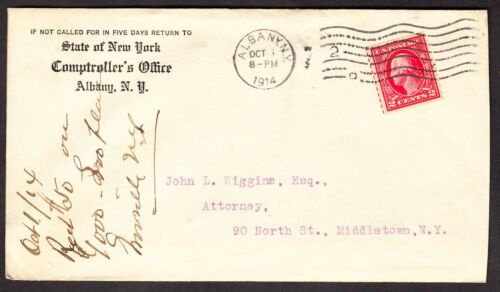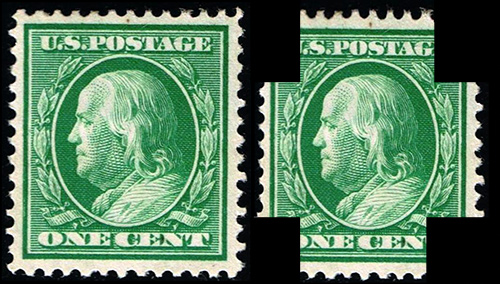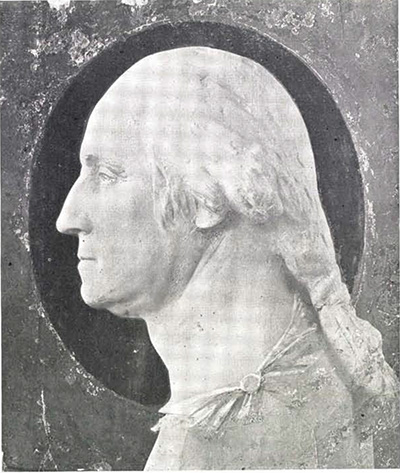Basic Info
2¢ carmine, deep carmine, red
TYPE I
Printing Method: FLAT PLATE
Subject: George Washington
Number issued: 962,708,000
Perforations: 10 horizontally
Watermark: Single Line USPS wmk
Scott #: 442
Issued: July 22, 1914
Value
As Pairs
Used
$1 - $6
No postmark with gum (MH)
$4 - $11
Full perfect gum, no postmark
no trace of stamp hinge mark (MNH)
$20 - $25
Add 75% if the pair has a line between the stamps (Line Pair)
As Singles
Used
$1 - $5
No postmark with gum (MH)
$11-$20
Full perfect gum, no postmark
no trace of stamp hinge mark (MNH)
$30 - $40
Earliest Known Use

A #442 coil on cover with typical stripe duplex cancel
Why so common?
It was current for only a little over two months and it is surprising to note how many were saved by philatelists, due no doubt to the fact that it was a new variety caused by a change in perforations that could not be easily overlooked and dealers immediately stocked it. This was in marked contrast to the endwise coil (#444) which was issued about three months later which though current for almost a year and a half was almost entirely overlooked.
The Watermark

The watermark consists of single lined USPS letters. A stamp may show only part of a letter or letters
Flat Plate?


As the curved plates of the Rotary press made the stamps slightly larger, it is relatively easy to discern which stamp is flat plate and which is a rotary press stamp. First, select any perf Washington Franklin stamp or the first issue Washington Franklin 1 cent or 2 cents. These are the stamps with the numbers one and two spelled out instead of numbers displayed. I chose the latter alternative, as shown in the first image above.
Then cut out squares at each corner, as shown in the second image above. Placing the stamp, you wish to test under your cut-out stamp to test if the frame lines match. If, as in the last image shown above, the frame lines are outside the top stamp in either the top, bottom, or sides then you have a rotary stamp. If the lines are in the same place, you have a flat plate stamp, as shown in the third image.
This test works with any value stamp.
The Design Inspiration

Using this photograph, the stamp designer Clair Aubrey Huston added the toga cord and button. The engravers of the stamp were M.W. Baldwin (who engaged almost all US stamps of this era. The lettering was engraved by Robert F. Ponicka and Edward M. Hall.
How to identify a Type I
THE LEFT RIBBON'S DISTINGUISHING FEATURE

TYPE I, Ia and II
There is but a single shading line in the top fold of the ribbon at the left.
TYPE III
There are two shading lines in the top fold of the ribbon at the left.
THE RIGHT RIBBON'S DISTINGUISHING FEATURES

TYPE I, Ia and II
There is but a single shading line in the bottom fold of the ribbon at the right.
TYPE III
There are two shading lines in the bottom fold of the ribbon at the right

TYPE I and Ia
The first shading line after the first ribbon fold of the right ribbon often appears as a single, unbroken line. At times there maybe one or two indistinct breaks. The bottom third of the line often appears stronger
TYPE II and III
The first shading line after the first ribbon fold of the right ribbon usually appears as a series of three dashes
THE BUTTON'S DISTINGUISHING FEATURE

TYPE I
The outline of the toga button is thin and sometimes broken
TYPE Ia
The outline of the toga button is stronger than the other types
TYPE II and III
The outline of the toga button is complete and fairly strong
THE LOCK OF HAIR'S DISTINGUISHING FEATURE

TYPE I and Ia
The lock of hair on Washington's cheek will show only a faint, often broken, vertical line along its left edge. It will be slightly stronger on type Ia, but not as strong as type II and III
TYPE II
The lock of hair on Washington's cheek will show a distinct vertical line along its left edge, joining at least four of the horizontally engraved lines of the cheek
TYPE III
The lock of hair on Washington's cheek will show a distinct vertical line along its left edge, joining at least five of the horizontally engraved lines of the cheek
THE MOUTH'S DISTINGUISHING FEATURE

TYPE I
The dark line forming the mouth is almost straight or may even curve slightly upward at the corner of the mouth
TYPE Ia
The dark line forming the mouth is a strong straight line with a downward stroke at the corner of the mouth
TYPE II
The dark line forming the mouth is crooked
TYPE III
The dark line forming the right end of the mouth is crooked and it also dips down
THE EAR'S DISTINGUISHING FEATURE

TYPE I and Ia
Directly below the ear there are several shading lines which are clearly severed, resulting in the appearance of a thin, white, vertical line
TYPE II
Directly below the ear there are several shading lines which are severed, and the breaks are narrower than those of the type I stamp. Thus the impression is of a thinner and shorter white line, although certainly more pronounced than the type III design.
TYPE III
Directly below the ear the shading lines have been closed up to such a point, that the thin white line visible in type I, Ia and type II designs has all but dissapeared.
THE PONYTAIL'S DISTINGUISHING FEATURE

TYPE I and Ia
The two lines shading the hair at the top of the ponytail, directly behind the ear are of unequal length
TYPE II
The two lines shading the hair at the top of the ponytail, directly behind the ear are approximately the same length, the bottom one being very slightly shorter
TYPE III
The two lines shading the hair at the top of the ponytail, directly behind the ear are approximately the same length, the top one can be slightly longer








